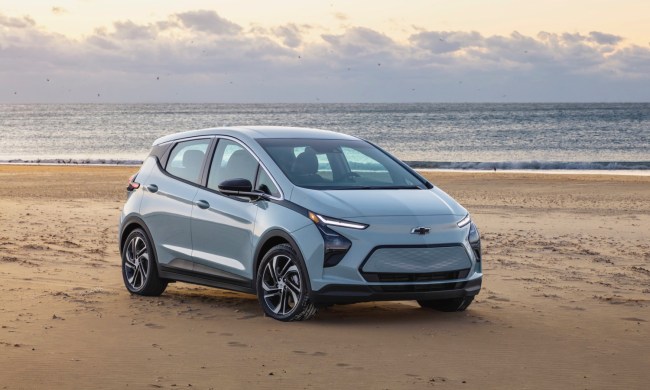 Stephen Edelstein/Digital Trends
Stephen Edelstein/Digital Trends
General Motors and LG Energy Solution have announced a new phase in their ongoing partnership: developing a new battery cell chemistry that could significantly lower the cost of electric vehicles. The joint effort centers on lithium manganese iron phosphate (LMFP) battery cells, a variation of lithium iron phosphate (LFP) that’s gaining popularity for being more affordable and less reliant on expensive materials like nickel and cobalt.
This is a big deal because battery costs are still the single largest expense in producing EVs. According to GM and industry experts, LMFP cells could help bring the cost of electric vehicles close to — or even on par with — gas-powered cars. The goal? Making EVs accessible to a broader range of drivers without sacrificing range or performance.
GM plans to use these LMFP batteries in future Ultium-based EVs, its modular electric platform that underpins models like the Chevrolet Equinox EV and Blazer EV. Those models are priced starting around $35,000–$50,000 — still noticeably higher than GM’s most popular internal combustion engine (ICE) vehicles like the gas-powered Equinox and Silverado, which often start closer to $28,000 and $36,000, respectively.
If LMFP batteries can knock down those EV prices, that gap could shrink fast. This would be key to helping GM hit its long-term EV adoption targets while maintaining profitability. Unlike some pricier battery chemistries, LMFP batteries are more stable and cost-efficient, especially when produced at scale. GM and LG say production of these new cells will happen in the U.S., supporting domestic supply chains and eligibility for tax incentives.
In short, this partnership isn’t just a science experiment — it’s a step toward solving one of the EV market’s biggest roadblocks: affordability. If successful, it could mark a turning point in the electric era, where choosing an EV no longer means paying a premium.

Nick Godt has covered global business news on three continents for over 25 years.
Chevy will pay charging-station installation costs for 2022 Bolt EV buyers

If you're buying an electric car, chances are you'll need a place to plug it in. Chevrolet knows that, so it's covering home-charging installation costs for buyers of the 2022 Bolt EV and Bolt EUV. However, the offer only lasts through June, and comes with some caveats, according to InsideEVs.
Chevy, through partner Qmerit, will install a NEMA 14-50 outlet fed by a dedicated 50-amp circuit with its own breaker. This is the kind of outlet used by large appliances, and it also allows so-called Level 2 charging, at 240 volts (a standard 120-volt household outlet is considered Level 1). However, Chevy is only covering what it calls a "standard installation," so any added costs will be the customer's responsibility.
2022 Chevy Bolt EV and Bolt EUV: More electric cars to love

As the first mass-produced electric car with more than 200 miles of range and a price below $40,000, the first-generation Chevrolet Bolt EV was a giant leap toward a zero-emission future. Chevy can't rest on its laurels, though. With rivals launching their own mass-market electric cars—encouraged by stricter global emissions standards—the Bolt EV was in need of an update.
General Motors didn't just update the Bolt EV, though, it added a new SUV-like variant alongside the existing hatchback. The 2022 Chevrolet Bolt EUV will go on sale alongside the 2022 Chevrolet Bolt EV this summer. The Bolt EUV is also the first non-Cadillac model to get GM's Super Cruise driver-assist tech, while the Bolt EV gets a restyling inside and out.
Uber partners with May Mobility to bring thousands of autonomous vehicles to U.S. streets

The self-driving race is shifting into high gear, and Uber just added more horsepower. In a new multi-year partnership, Uber and autonomous vehicle (AV) company May Mobility will begin rolling out driverless rides in Arlington, Texas by the end of 2025—with thousands more vehicles planned across the U.S. in the coming years.
Uber has already taken serious steps towards making autonomous ride-hailing a mainstream option. The company already works with Waymo, whose robotaxis are live in multiple cities, and now it’s welcoming May Mobility’s hybrid-electric Toyota Sienna vans to its platform. The vehicles will launch with safety drivers at first but are expected to go fully autonomous as deployments mature.
May Mobility isn’t new to this game. Backed by Toyota, BMW, and other major players, it’s been running AV services in geofenced areas since 2021. Its AI-powered Multi-Policy Decision Making (MPDM) tech allows it to react quickly and safely to unpredictable real-world conditions—something that’s helped it earn trust in city partnerships across the U.S. and Japan.
This expansion into ride-hailing is part of a broader industry trend. Waymo, widely seen as the current AV frontrunner, continues scaling its service in cities like Phoenix and Austin. Tesla, meanwhile, is preparing to launch its first robotaxis in Austin this June, with a small fleet of Model Ys powered by its camera-based Full Self-Driving (FSD) system. While Tesla aims for affordability and scale, Waymo and May are focused on safety-first deployments using sensor-rich systems, including lidar—a tech stack regulators have so far favored.
Beyond ride-hailing, the idea of personally owned self-driving cars is also gaining traction. Waymo and Toyota recently announced they’re exploring how to bring full autonomy to private vehicles, a move that could eventually bring robotaxi tech right into your garage.
With big names like Uber, Tesla, Waymo, and now May Mobility in the mix, the ride-hailing industry is evolving fast—and the road ahead looks increasingly driver-optional.
.png)











 English (US) ·
English (US) ·